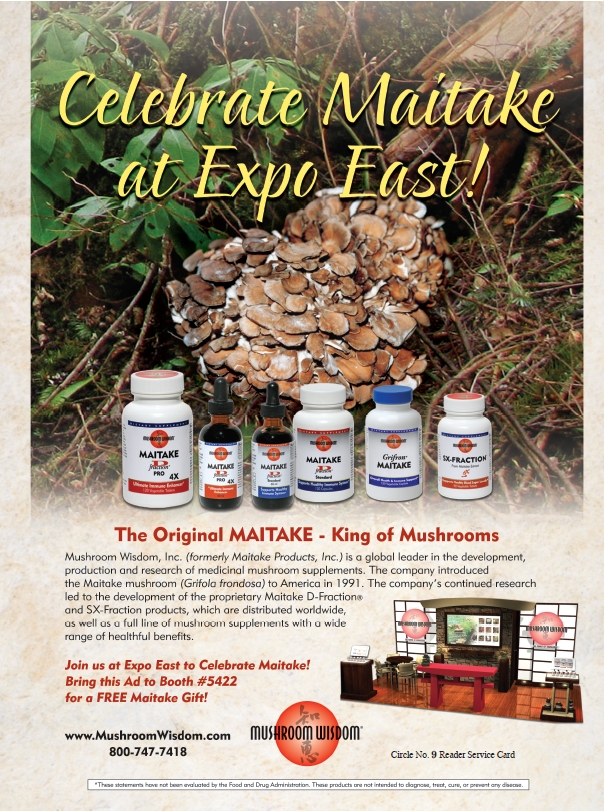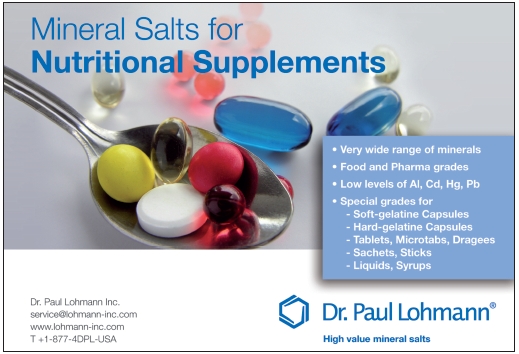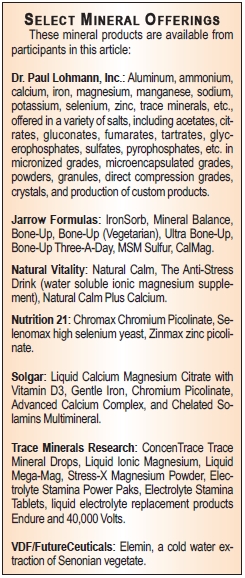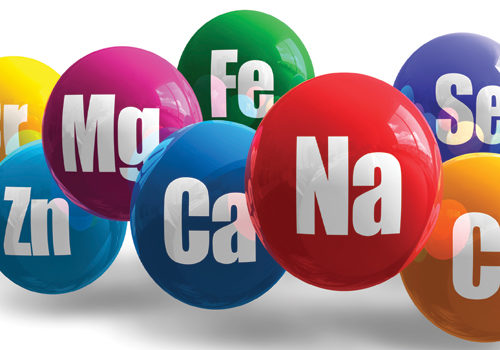Kids are taught how to balance, whether it’s learning to walk, carrying dinner plates to the sink or keeping the momentum on a seesaw without falling off. Most Americans are not applying what they learned on the playground to their eating habits. Too many are letting their nutrition crash to the ground by not achieving their recommended dietary allowance (RDA) of minerals such as iron, while other minerals, like calcium, are sometimes devoured to a dangerous extent.
Although each individual’s needs vary, minerals are an integral part of diet and continued healthy body function that must be replenished every day, whether it is with healthy eating or supplements, to keep precious nutritional balance.
Minerals Explained
Minerals are inorganic elements that can be divided into two categories: macro (needed in bulk on a daily basis) and trace (needed in a smaller amount than macro everyday) (1). Some trace minerals include chromium, copper, iodine, iron, selenium and zinc, while macro minerals include calcium, phosphorus, potassium, sodium and magnesium (1).
Bodies are like machines, dependent on dietary minerals to keep their thousands of daily functions running smoothly. Over time, not supplying the machine with the proper minerals can begin to cause problems.
“An individual who is deficient may experience a myriad of issues that may seem almost insignificant at first, but can have a much more damaging and far-reaching effect on their health than they may think,” says Darrin Starkey, N.D., director of education and training for Trace Minerals Research, Ogden, UT. “From a supplementation standpoint, you can find just about any mineral out on the market that you might want to take. However, it is important to understand that all too often we focus on the ‘big’ minerals/ones that are trending and omit the others.”
One example is zinc (which helps with immune response) in that it often does not get paired with potassium, magnesium, manganese, copper and chromium, all needed for zinc’s optimum effectiveness.
Keeping the Balance
To avoid mineral deficiencies or overindulgence, the most basic way to get the daily recommended dosages is by eating a healthy, well-rounded diet and taking a multimineral/vitamin. An easy analogy to offer consumers about how minerals work is to imagine the body as a house being built: you can’t skip laying down the groundwork to start putting in the furniture. Before trying the extreme, advise consumers to start with the basics.
 “We have to remember that we have tried to decorate our ‘house of health’ before we have even built the foundation,” says Starkey. “We take all kinds of exotic products before securing the ground floor, and then are surprised when the winds of ill health begin to blow and our house begins to fall apart (pain and health issues).”
“We have to remember that we have tried to decorate our ‘house of health’ before we have even built the foundation,” says Starkey. “We take all kinds of exotic products before securing the ground floor, and then are surprised when the winds of ill health begin to blow and our house begins to fall apart (pain and health issues).”
According to Denise McKee, Ph.D., technical support/scientific affairs at Jarrow Formulas, Los Angeles, CA, some of the best sources of essential macrominerals are milk, yogurt and cheese for calcium; meats, fish and dairy for phosphorus; dark leafy greens, nuts and fruits for magnesium; eggs, meats, poultry and fish for sulfur; and avocado, fish, dried beans, raisins, nuts, bananas and sweet potatoes for potassium.
But, even with a strategic, healthy diet, many consumers are missing out on important minerals due to a phenomenon out of their control. Soil depletion, mainly caused by the overuse of chemical fertilizer and aggressive farming, is a factor in the reduction of minerals and vitamins naturally found in produce.
“Modern fertilizers have a fairly narrow range of mineral replenishment and primarily focus on nitrogen, phosphorous, potassium, calcium and magnesium,” says Hartley Pond, vice president of technical sales at VDF/FutureCeuticals, Momence, IL. “These are all important, but do not replenish our soil and food with a full array of important minerals, and combined with a modern diet of highly processed foods devoid of natural minerals has led to deficiencies in our diet.”
Even without the use of chemical fertilizer, as in organic farming, soil erosion and quality can also play a factor in mineral depletion.
“The general level of nutrients in our fruits and vegetables has been declining, with the nutritional content in foods now ranging from 15 to 75% less than what it was half a century ago,” says Ken Whitman, president of Natural Vitality, Austin, TX. “On a practical level, you would have to eat five apples today to get the nutrients you would have gotten from one apple in 1960.”
It’s no wonder, then, why many Americans have mineral deficiencies and are turning to supplementation for help.
Iron Out the Kinks
Iron deficiency, for instance, is the most common deficiency in the United States, according to the Centers for Disease Control and Prevention (CDC) (2). Iron in hemoglobin carries oxygen from the lungs to the rest of the body and helps muscles store and use oxygen, while it helps digest food, supports cell function and benefits other bodily functions as part of enzymes (2). Mild iron deficiency does not have much of an effect on overall health, but severe iron deficiency can result in anemia, which affects the functioning of organ systems. Iron deficiency can cause a myriad of problems that  include fatigue, weakness, decreased performance at work or school, circulation problems, weakened immune function, delayed motor or mental skills in infants and, if it occurs during pregnancy, small or early babies who have more risk of health problems than babies brought to full term and size (2).
include fatigue, weakness, decreased performance at work or school, circulation problems, weakened immune function, delayed motor or mental skills in infants and, if it occurs during pregnancy, small or early babies who have more risk of health problems than babies brought to full term and size (2).
“Iron deficiency can be caused not only by poor diet, but can also be a result of menstruation, pregnancy, physical activity or donating blood regularly,” says Patrick Stano, vice president of sales and marketing for North America at Dr. Paul Lohmann, Inc., Islandia, NY.
Depending on age and gender, the daily RDA changes. For women aged 14 to 50, about 18 mg/day is sufficient, while pregnant women require 27 mg/day. Males of all ages require 8 to 11 mg/day (2). The CDC recommends preventing anemia by following a healthy diet and adhering to the RDA. This is not easy for all consumers, however.
“Great food sources for iron includes dried beans, egg yolks, salmon and whole grains. However, the inconvenience of preparing some of these foods can be an obstacle with a modern, American lifestyle,” says McKee.
Thus, some individuals many need support from iron supplements. Iron has a rep for being difficult to digest, causing stomach discomfort. So, formulators often choose forms like iron protein succinylate or iron bisglycinate as gentler, better absorbable forms. “An important factor to consider when monitoring iron intake is the amount of absorbable iron, referred to as elemental iron,” says McKee. “This is the case in both food and supplement sources. Iron from some food sources is more difficult to absorb than other sources. The best approach to take is combining foods with a good source of iron, for example a meal with fish, beans, and dark leafy greens, to increase iron absorption and/or take an elemental iron supplement.”
Combining iron and vitamin C is another way to help absorption, but consumers also are turning to chelated minerals (i.e., minerals chemically combined with amino acids to create “complexes”). These minerals are used for building muscle and bones and supporting the immune system (3), “such as chelated iron, as well as different forms of calcium, such as calcium citrate of calcium carbonate,” says Angelica S. Vrablic, Ph.D., manager of nutrition research at Solgar, Leonia, NJ.
 Dynamic Duo: Calcium and Magnesium
Dynamic Duo: Calcium and Magnesium
Vrablic’s point leads us to the other end of the scale: calcium. This mineral is used to fortify everything from orange juice to breakfast cereal for promoting strong teeth and bones, something everyone can agree are necessary to actively preserve. But, you know what they say about too much of a good thing.
“Calcium has become a hugely over-consumed mineral,” says Starkey. “However, it’s not that we are calcium deficient now, as a society, but rather are lacking the mineral that acts synergistically with it: magnesium. As a result, recent research estimates that 54–75% of the population is not achieving its daily magnesium requirements. Specifically, we are focusing too much on individual minerals instead of looking to balance ourselves with a wide range of minerals and trace minerals.”
To properly absorb and use calcium in the body, consumers need to know how the mineral interacts with other elements. For example, magnesium is calcium’s often overlooked partner in absorption.
“What has been largely ignored is the fact that calcium and magnesium work together,” says Whitman. “Calcium excites nerves and is necessary for muscle contraction. Magnesium, on the other hand, calms nerves and is needed for muscle relaxation. When a cell is at rest, magnesium is on the inside and calcium is on the outside. When a cell is active, calcium flows into the cell and magnesium moves out. An imbalance with too much calcium and not enough magnesium is like having a light switch that won’t turn off.”
The perfect ratio of calcium-to-magnesium is 2:1, but the majority of people (80% of men and 70% of women) are not getting their daily requirement, leading to an imbalance of 4:1, 5:1 or more, says Whitman. Despite an increase in calcium usage, the imbalance of other minerals is clear when compared with years of being taught that calcium will help prevent osteoporosis. But, there’s more to it than drinking a glass of milk.
“For decades women have been encouraged to take high amounts of calcium to prevent osteoporosis,” says Whitman. “In addition, dairy companies have touted the calcium in their products and other processed food manufacturers have added calcium to their products. This great concentration on calcium supplementation has not eliminated the problem of osteoporosis or osteoporotic bone fractures. If it was the simple solution we would not continue to have the problem.”
to take high amounts of calcium to prevent osteoporosis,” says Whitman. “In addition, dairy companies have touted the calcium in their products and other processed food manufacturers have added calcium to their products. This great concentration on calcium supplementation has not eliminated the problem of osteoporosis or osteoporotic bone fractures. If it was the simple solution we would not continue to have the problem.”
The complexities of calcium absorption extend beyond magnesium to vitamin D. “It is recommended to take calcium supplements with vitamin D to increase its absorption,” says McKee. She reminds us of the value of balancing vitamins and mineral, which “work harmoniously together in the body. Therefore, grouping certain vitamins and minerals is very important.”
Without enough vitamin D, calcium is insufficiently absorbed into the body, therefore calcium is leeched from bones to compensate, which can weaken existing bone and make repairs to new ones more difficult (4). Vitamin K2 is also required for calcium assimilation.
 Before moving on, one should understand that there’s more to magnesium than just support for calcium. While the mineral is often misused or underused, it is beginning an upward trend back into consumers’ lives as an aid in reducing stress. “Magnesium is the anti-stress mineral and stress is a huge issue these days,” says Whitman. “While magnesium is a fundamental nutrient the body needs to function properly, it is also becoming more popular because of its ability to assist sleep, alleviate cramping, constipation and positively affect mood.”
Before moving on, one should understand that there’s more to magnesium than just support for calcium. While the mineral is often misused or underused, it is beginning an upward trend back into consumers’ lives as an aid in reducing stress. “Magnesium is the anti-stress mineral and stress is a huge issue these days,” says Whitman. “While magnesium is a fundamental nutrient the body needs to function properly, it is also becoming more popular because of its ability to assist sleep, alleviate cramping, constipation and positively affect mood.”
Bioavailability or Bust
Unfortunately, some individuals have problems digesting minerals, and thus bioavailability can be a problem. This is the rate and extent of how well and quickly an element in a supplement, for example, gets into the bloodstream. “Many commercial mineral supplements are rock- or salt-based minerals comprised of very large molecules that are very difficult for the body to digest,” says Pond. “They are often hydrophobic and hence have low bio-availability.”
Taking the most bioavailable minerals is especially important for those who suffer from malabsorption due to heath problems or those with diet limitations. “People with celiac disease are more susceptible to mineral deficiencies,” says McKee. “Vegetarian and vegan diets make it more difficult to obtain adequate amount of minerals from foods as well. In these cases, mineral supplementation can be very effective.”
For these folks, Starkey suggests ionic minerals for optimal absorption. “They are in their smallest and most natural form and are easier for the body to assimilate. With the digestive disorders that are plaguing society today, having a mineral ‘ready to use’ is more important than ever,” he states.
As a way to circumvent depletion, bioavailability and digestion problems, consumers are also looking to plant-based minerals. “They are hydrophilic, negatively charged, water soluble and extremely small relative to rock or salt-based, positively charged minerals found in many supplements,” says Pond. One kind of plant-based mineral, Pond cites, is Senonian vegetate, compressed plant deposits found within the earth in the Cretaceous Strata, which contain the preserved minerals and nutrients of the ancient soil underground.
This isn’t the only option for increasing absorption. “There are various forms of minerals and certain forms are more easily absorbed than others. This is particularly important with essential trace minerals,” says Bill Levi, vice president of sales and marketing at Nutrition 21, Purchase, NY. “Trace minerals are not easily absorbed so that they can be utilized by the body…When thinking quality, one needs to take into consideration the purity of the product as well as the efficacy of the specific form of the mineral.”
The delivery method can also affect mineral absorption. “The multivitamin/mineral tablet still seems to be the predominant form of mineral supplementation; however, many other delivery methods are now in use today, including capsules, gelcaps, liquids, gels, stick packs, powders, chews, etc. These are all designed as more convenient forms compared to the tablet,” says Stano.
The choice of delivery also can impact a formula’s efficacy or improve compliance. “Many minerals are very low in bioavailability and are not absorbed by the body as well,” says Stano. “While other minerals have taste issues and may interact with other ingredients in a blend, a microencapsulated mineral may be beneficial in this instance. Other properties to consider would be the solubility of a mineral, the color, the taste, the metal content, and the form (powder, granule, crystal, etc.).”
In fact, according to Starkey, liquids and powders are growing in popularity amongst baby boomers, as well as electrolytes and chromium for weight loss.
“We prefer liquids because all forms of supplements eventually have to become liquid to be absorbed,” says Whitman. “Starting with a liquid fast tracks the process and ensures that you get what you’re paying for.”
Quality Pays
The quality of mineral supplements, like all things in life, comes down to, “you get what you pay for.”
“Price is often an indication of the quality of individual ingredients,” says Whitman. “Premium raw ingredients are more expensive. Different forms of minerals are more or less costly. The cheapest forms, as with types of calcium and magnesium, are often the least absorbable.”
Along with premium ingredients, it’s also important to note how manufacturers choose to handle their products.
“The quality of a mineral can be measured by the manufacturer’s ability to meet tight specifications while maintaining batch to batch consistency,” says Stano. “In addition, the supplier’s manufacturing history, equipment, and operating procedures and practices all can result in higher quality products.”
Keeping all of these factors in mind is important when helping consumers find what is going to work best for their specific needs. WF
References
1. Calcium, http://ods.od.nih.gov/factsheets/Calcium-HealthProfessional/, accessed August 2, 2012.
2. Iron and Iron deficiency, http://www.cdc.gov/nutrition/everyone/basics/vitamins/iron.html, accessed August 2, 2012.
3. Chelated Minerals, http://www.webmd.com/vitamins-supplements/ingredientmono-41-CHELATED%20MINERALS.aspx?activeIngredientId=41&activeIngredientName=CHELATED%20MINERALS, accessed August 2, 2012.
4. Calcium and Vitamin D: Important at Every Age, http://www.niams.nih.gov/health_info/bone/bone_health/nutrition/#d, accessed August 7, 2012.
Published in WholeFoods Magazine, September 2012









